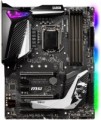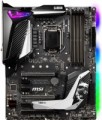Add to comparison |  |  |
|---|---|---|
| MSI MPG Z390 GAMING PRO CARBON | MSI MPG Z390 GAMING PRO CARBON AC | |
from £131.96 | Outdated Product | |
| TOP sellers | ||
| Main | Massive heatsinks on power circuits. RGB lighting with MSI Mystic Light Sync control. Two reinforced PCI-E slots supporting 2-Way SLI and 3-Way CrossFire. 4 DDR4 slots supporting up to 4400 MHz. Two high-speed slots m.2. Unlike the MPG Z390 GAMING PRO CARBON AC model, it does not have built-in WIFI. | Massive heatsinks on power circuits. RGB lighting with MSI Mystic Light Sync control. Two reinforced PCI-E slots supporting 2-Way SLI and 3-Way CrossFire. 4 DDR4 slots supporting up to 4400 MHz. Two high-speed slots m.2. Built-in WIFI (1.73Gbp) |
| Features | gaming for overclocking | gaming for overclocking |
| Socket | Intel LGA 1151 v2 | Intel LGA 1151 v2 |
| Form factor | ATX | ATX |
| Power phases | 11 | 11 |
| VRM heatsink | ||
| LED lighting | ||
| Lighting sync | MSI Mystic Light Sync | MSI Mystic Light Sync |
| Size (HxW) | 304x243 mm | 304x243 mm |
Chipset | ||
| Chipset | Intel Z390 | Intel Z390 |
| BIOS | Ami | Ami |
| UEFI BIOS | ||
RAM | ||
| DDR4 | 4 slot(s) | 4 slot(s) |
| Memory module | DIMM | DIMM |
| Operation mode | 2 channel | 2 channel |
| Max. clock frequency | 4400 MHz | 4400 MHz |
| Max. memory | 128 GB | 128 GB |
| XMP | ||
Drive interface | ||
| SATA 3 (6Gbps) | 6 | 6 |
| M.2 connector | 2 | 2 |
| M.2 | 2xSATA/PCI-E 4x | 2xSATA/PCI-E 4x |
| M.2 SSD cooling | ||
| Integrated RAID controller | ||
Expansion slots | ||
| 1x PCI-E slots | 3 | 3 |
| PCI-E 16x slots | 3 | 3 |
| PCI Modes | 16x/0x/4x, 8x/8x/4x | 16x/0x/4x, 8x/8x/4x |
| PCI Express | 3.0 | 3.0 |
| CrossFire (AMD) | ||
| SLI (NVIDIA) | ||
| Steel PCI-E connectors | ||
Internal connections | ||
| USB 2.0 | 2 | 2 |
| USB 3.2 gen1 | 2 | 2 |
| USB C 3.2 gen2 | 1 | 1 |
Video outputs | ||
| HDMI output | ||
| DisplayPort | ||
Integrated audio | ||
| Audiochip | Realtek ALC1220P-VB2 | Realtek ALC1220P-VB2 |
| Sound (channels) | 7.1 | 7.1 |
| Optical S/P-DIF | ||
Network interfaces | ||
| Wi-Fi | Wi-Fi 5 (802.11aс) | |
| Bluetooth | Bluetooth v 5.0 | |
| LAN (RJ-45) | 1 Gbps | 1 Gbps |
| LAN ports | 1 | 1 |
| LAN controller | Intel I219-V | Intel I219-V |
External connections | ||
| USB 2.0 | 2 | 2 |
| USB 3.2 gen2 | 3 | 3 |
| USB C 3.2 gen2 | 1 | 1 |
Power connectors | ||
| Main power socket | 24 pin | 24 pin |
| CPU power | 8+4 pin | 8+4 pin |
| Fan power connectors | 7 | 7 |
| Added to E-Catalog | october 2018 | october 2018 |